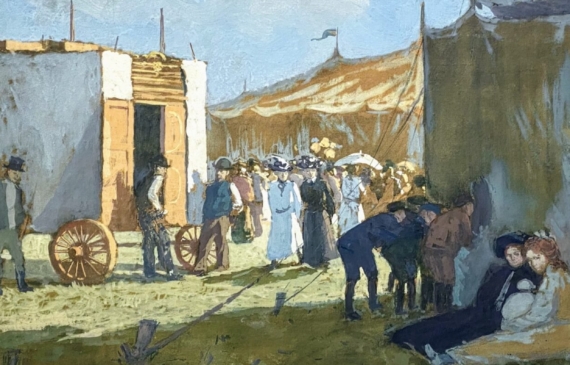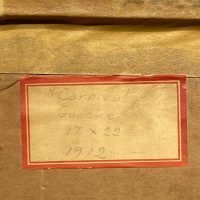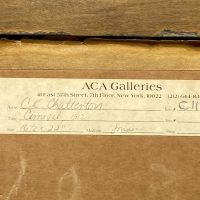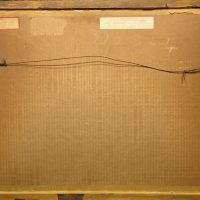C.K. Chatterton




C.K. Chatterton (American, 1880-1973)
Carnival
Gouache on board, 16 ½ H. x 22 W. inches
Artist Description
Clarence K. Chatterton, impressionist painter and teacher was born in Newburgh, New York, September 19th, 1880. He studied at the New York School of Art under Luis Mora, Robert Henri, Kenneth Hayes Miller and William Merritt Chase. During his life he credited Robert Henri with having the greatest influence on his artistic career and one can clearly see similarities in their work of every-day scenes, straight forwardness, bold approach and strong color.
Clarence Chatterton exhibited with Henri’s disciples at the MacDowell Club, one of a few exhibition spaces available to the “new” group of “rebellious” social realist artists working at the turn of the century. Chatterton said of Henri: “Over and over again Henri would say that he cared nothing for the technical proficiency we had been taught by previous masters. To those of us who were technically clever, this was baffling and occasionally galling, for he often praised awkward drawings by beginners and remained silent when staring at the work of good craftsman. The idea and the emotion were all important, the manner of conveying them negligible. Today this is commonplace; 60 years ago it was revolutionary.”
At one such exhibition Chatterton sent along a painting to be hung, and on the back was another work he rejected as sub-par. Upon seeing the work, the now legendary artist George Bellows (who was hanging the show) called him up and said “Chat, we all like the one on the back better! In fact, we think it’s the best thing in the show, can we turn the canvas? Naturally he did not object to such a request from so well a respected artist as Bellows, and “it has remained so turned ever since.”
From 1915-1948 Chatterton was Professor Emeritus of Art and artist-in-residence at Vassar College in Poughkeepsie, New York. He was considered somewhat of a pioneer in this regard as few other artists were in such a position, especially considering that Vassar was strictly an all-girls school at the time. There Chatterton established the Department of Applied Arts, and this “credited” department was to become an early model of instruction similar to that found in the dedicated art schools of the time. This did not come easy as there were objections from some of the faculty in giving academic credit to such a class. One member stated: “we might as well give credit for a course in plumbing.” Nevertheless he prevailed in bringing forth a curriculum that was both revolutionary in content and ahead of its time. Many of the 3000 students he was credited with teaching went on to become successful members of the art world.
In 1925, Chatterton had his first one-man exhibit at the Wildenstein Gallery. This was particularly noteworthy due to the fact that his show hung with the first New York showing of Parisien painter Toulouse Lautrec, and remarkably Chatterton held his own against the noted Frenchman and was awarded a second showing at Wildenstein. He was the first American to ever have exhibited at the aforementioned gallery. He chose as his subject matter, “small town USA,” a subject he would pursue for the rest of his career.
He was also known for genre, portraits, landscapes, harbors, streets, parks and beaches. He painted mostly in the Hudson Valley and Maine. His bold, forthright approach to painting complimented the strong sentiment he displayed in his work for rural America.
A critic for The New York Times stated: “Mr. Chatterton’s point of view is characterized by certain serene enjoyment of actualities that amount almost to a philosophy of life. His pictures of New England villages and streets, of meadows and trees and white meeting houses induce something of the same reaction that one gets from reading Thoreau and Emerson. His manner of setting down his reactions has the integrity of his point of view which is characterized by directness and candor.” His paintings combine a Plein-Air painting tradition with Social Realism content displayed “with forthrightness about homely subject matter” a sort of social impressionist if you will.
Exhibition venues include Macbeth Gallery* in New York, 1927, one-man in 1931,34 and 36; the Pennsylvania Academy of Fine Art; Toledo Museum of Art; Art Museum of St. Louis; Montclair Art Museum; University of Minnesota; National Academy of Design; Rochester Memorial Art Gallery; Brooklyn Museum; Rhode Island School of Design; World’s Fair; Chicago Art Institute; Carnegie international Exhibition; National Exhibition of American Art, Rockefeller Center; Chapellier Gallery; Corcoran Gallery, Washington, DC; Golden Gate Expo., San Francisco and others.
He was a member of the Salmagundi Club; Chicago Watercolor Club and others. He won numerous awards including Isidor prize, Salmagundi Club, 1913. In 1910, his painting the Snow Clad Town was included in the first showing of United States Art in South America. In 1926 his painting Clinton Square Newburgh was selected for the Tri-National Exhibit sent abroad under sponsorship of Wildenstein Gallery.

